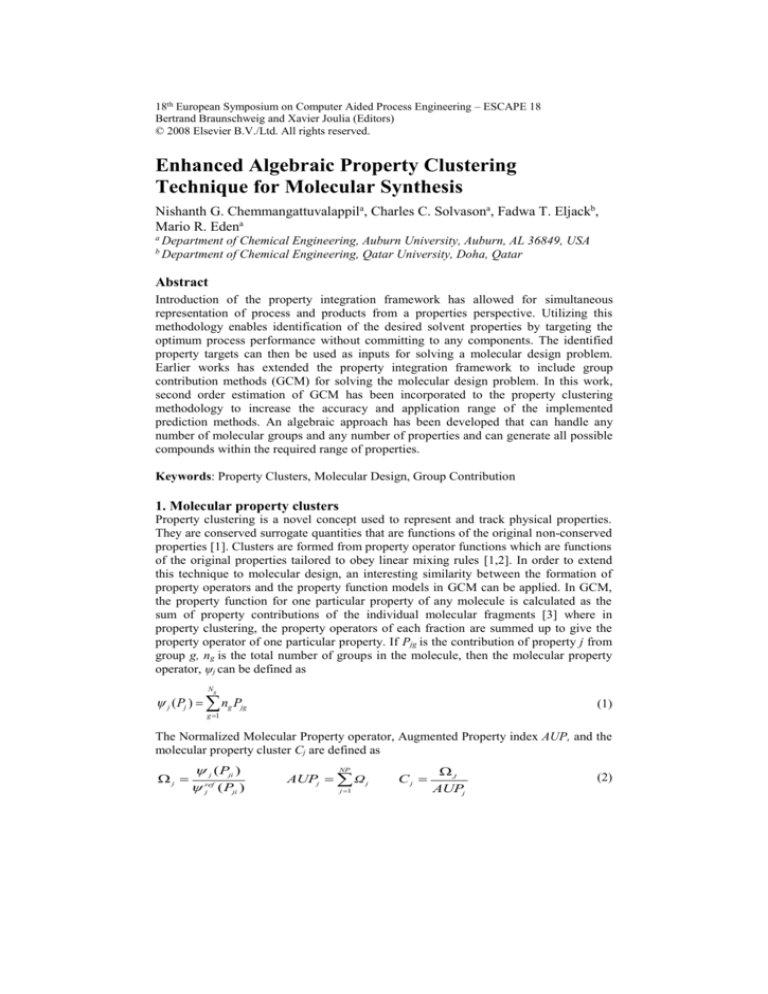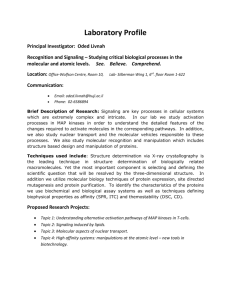
18th European Symposium on Computer Aided Process Engineering – ESCAPE 18
Bertrand Braunschweig and Xavier Joulia (Editors)
© 2008 Elsevier B.V./Ltd. All rights reserved.
Enhanced Algebraic Property Clustering
Technique for Molecular Synthesis
Nishanth G. Chemmangattuvalappila, Charles C. Solvasona, Fadwa T. Eljackb,
Mario R. Edena
a
b
Department of Chemical Engineering, Auburn University, Auburn, AL 36849, USA
Department of Chemical Engineering, Qatar University, Doha, Qatar
Abstract
Introduction of the property integration framework has allowed for simultaneous
representation of process and products from a properties perspective. Utilizing this
methodology enables identification of the desired solvent properties by targeting the
optimum process performance without committing to any components. The identified
property targets can then be used as inputs for solving a molecular design problem.
Earlier works has extended the property integration framework to include group
contribution methods (GCM) for solving the molecular design problem. In this work,
second order estimation of GCM has been incorporated to the property clustering
methodology to increase the accuracy and application range of the implemented
prediction methods. An algebraic approach has been developed that can handle any
number of molecular groups and any number of properties and can generate all possible
compounds within the required range of properties.
Keywords: Property Clusters, Molecular Design, Group Contribution
1. Molecular property clusters
Property clustering is a novel concept used to represent and track physical properties.
They are conserved surrogate quantities that are functions of the original non-conserved
properties [1]. Clusters are formed from property operator functions which are functions
of the original properties tailored to obey linear mixing rules [1,2]. In order to extend
this technique to molecular design, an interesting similarity between the formation of
property operators and the property function models in GCM can be applied. In GCM,
the property function for one particular property of any molecule is calculated as the
sum of property contributions of the individual molecular fragments [3] where in
property clustering, the property operators of each fraction are summed up to give the
property operator of one particular property. If Pjg is the contribution of property j from
group g, ng is the total number of groups in the molecule, then the molecular property
operator, ψj can be defined as
Ng
j ( Pj ) ng Pjg
(1)
g 1
The Normalized Molecular Property operator, Augmented Property index AUP, and the
molecular property cluster Cj are defined as
j
j ( Pji )
ref
( Pji )
j
NP
AUPj Ω j
j 1
Cj
J
AUPj
(2)
2
N.G. Chemmangattuvalappil et al.
The molecular property operators developed in the above mentioned method can only
be used for the design of simple monofunctional molecules as they are based only on
first order groups [4-6]. Second order group effects must be incorporated into the design
for long chain molecules, to differentiate between isomers, and if the structural effects
of polyfunctional molecules and cyclic molecules are to be considered.
1.1. Second order groups and molecular design
In order to include the effect of second order groups in the property prediction, it is
possible to make use of the linear additive rules of second order groups. Second order
groups have first order groups as their building blocks [3] and hence they can be
considered as combinations of different first order groups. Overlapping of molecular
fragments in different second order groups is permitted as the second order groups
represent different kinds of interaction among the groups. However, if one group
completely overlaps another group, only the bigger group is to be selected to form the
second order group to avoid a redundant description of the same molecular fragment[4].
Suppose, the property target identified by the process design is represented as:
Pijlower Pij Pijupper
(3)
Where i is the index of molecules and j is the index of properties. Eq. (3) can be rewritten in terms of normalized property operator as:
min
ij max
j
j
(4)
Here, Ωij is the normalized property operator of molecule i. To estimate its value, first
calculate the normalized property operator based on first order estimation:
Ng
ijf ng jg1
(5)
g 1
Where, Ωjg1 is the normalized property operator of first order group, g. Utilize the
following rules to estimate the contributions of second order groups:
Rule1. Second order groups can only be formed from complete molecular
fragments.
Rule 2. If any of the second order groups completely overlap some other
second order group, only the larger group must be chosen in order to
prevent the redundant description of a same molecular fragment.
So, if (k:n)is the set of first order groups that are the building blocks of one second
order group, s, (ngk:ngn)is the number of those first order groups present in the molecule,
η is the number of occurrences of one particular first order group in a selected second
order group, ngs is the number of second order groups which can be generated from
those first order groups, then:
ngk
ngs Min
k
:
ngn
n
(6)
Enhanced Algebraic Property Clustering Technique for Molecular Synthesis
3
ngs must be rounded down to the nearest integer number according to Rule 1. If Ωjg2 is
the property contribution from the second order groups, the normalized property
operator for the property contributions from second order groups, Ωijs is calculated as:
Ns
ijs ngs jg 2
(7)
s 1
Rule 2 applies when some of the second order groups are completely overlapped by
some other groups. Consider (ngk:ngn) has subsets of smaller second order groups
(ngl:ngm) with some of the first order components of (ngk:ngn) and n*gs is the number of
those second order groups, then:
ngl ngm
ngk ngn
:
:
Min
l m
k n
ngs* Min
(8)
will be those groups which are not a part of any bigger second order groups. According
to Rule 1, this must be rounded down to the nearest integer. If Ωjg2 is the contribution
from the smaller second order groups, then the normalized property operator for the
property contributions from smaller second order groups, Ω*ijs can be calculated as:
Ns
*ijs n*gs *jg 2
(9)
s 1
The normalized property operator for molecule i can now be estimated as:
ij ijf ijs *ijs
(10)
It is evident from Eq. (4) that, for each property, there will be two inequality
expressions in the cluster space; one for the minimum value and the other for the
maximum value [3]. So there will be 2Np inequality expressions to represent all the
possible solutions. To solve for ng, combine Eq.s (4) and (8) and split it into two
equations for each property. Then, calculate the minimum and maximum values of AUP
for the given property constraints.
To identify the possible cyclic compounds, the decision on the groups to be the part of
the ring should be made ahead of design. This is to account for the difference in the
property contributions of the same group to cyclic and acyclic compounds. The
minimum number of molecular fragments that forms the ring (ngr) must be three to
ensure the existence of a ring. To make sure that the solutions of the above mentioned
equations and constraints produce complete molecular structures, there should not be
any free bonds in a molecule and the number of each group should be a non-negative
number. The mathematical expression for ‘Free Bond Number’ (FBN), which is the
number of valance electrons in each molecular string, is [7-9]:
Ng
Ng
FBN ng FBN g 2 ng 1 2 Nr
g 1
g 1
(11)
Where, Nr is the number of rings in the final molecule and FBNg is the number of free
bonds in each group. Based on these, the following expressions can be developed.
n g 0, n gr 3 or 0, FBN 0
(12)
4
N.G. Chemmangattuvalappil et al.
1.2. Algorithmic molecular design procedure
The procedure for formulating and solving the molecular design problem using the
algebraic cluster-based approach is given below:
1.
2.
3.
4.
5.
6.
7.
8.
Transform the required property range into sets of maxima and minima of the
molecular property operators using the corresponding functions in GCM.
Select the first order groups to form the candidate molecules
Using the contributions of each molecular fragment, develop inequality
expressions for each property. At this stage, use inequality expressions from
(4) and (5). Follow Rule 1 to generate second order groups
Determine AUP range of the sink
Evaluate FBNg of all groups and develop the structural constraints from (12).
To design acyclic compounds, use only those groups corresponding to acyclic
compounds. Then use the equations obtained through steps 4-6 (except the
expression for number of groups forming the ring) to evaluate the maximum
possible values of all first order groups. Set the minimum value of all groups as
zero. Then, with the obtained values, maximize and minimize the AUP range
to get a tighter bound on search space. Check whether the number of groups
changes. If so, recalculate AUP range using the new sets of maximum groups.
Repeat until the number of groups and AUP values become constant.
Generate all possible combinations of the range of groups obtained from step
6. Generate the molecular property operators for each combination using
Eq.(2-8). Evaluate the FBN and AUP values of all possible combinations. As,
satisfying AUP is a necessary but not sufficient condition, this step will reduce
the search space significantly. Back calculate the properties of those
compounds whose AUP is with in the range and FBN is zero for verification.
Repeat the same procedure for ring compounds including the molecular
fragments forming the rings and equations obtained through steps 4-6.
2. Case Study - Design of blanket wash solvent
Consider the design of blanket wash solvent for a phenolic resin printing ink. This
design was originally solved as a MINLP problem by Sinha and Achenie [10]. In this
work, the design has been done algebraically using molecular property operators [3,4].
The target property constraints to be satisfied by the solvents are listed in Table 1.
Table 1. Property constraints, operators and reference values
Property (Pj)
ψj
Ref.
value
Upper
bound
Lower
bound
Ωmin
Ωmax
Adjustable
Parameter
Standard heat of
vaporization, Hv
(kJ/mol)
Hv - hv0
20
20
60
0.413
2.413
11.733
exp T
t
bo
7
350
400
0.689
0.862
222.543
exp T
t
mo
7
150
300
0.395
1.093
147.45
20
10
20
0.64
1.14
-2.806
Normal boiling
point, Tb (K)
Normal melting
point, Tm (K)
Standard heat of
fusion, Hf (kJ/mol)
Hf - hf0
Enhanced Algebraic Property Clustering Technique for Molecular Synthesis
5
Table 2. Property data of selected molecular fragments [4]
g
1
2
3
4
5
6
7
8
9
Group
CH3
CH2
CH
OH
CHO
CH3CO
CH2CO
(CH2)ring
(CH)ring
FBN
1
2
3
1
1
1
2
2
3
hv1
0.217
4.91
7.962
24.214
12.37
15.195
19.392
3.341
6.416
tb1
0.8491
0.7141
0.2925
2.567
2.5388
3.1178
2.6761
0.8234
0.5946
tm1
0.6953
0.2515
-0.373
2.7888
3.0186
2.9588
2.5232
0.5699
0.0335
hf1
1.66
2.639
0.134
4.784
11.325
8.062
8.826
1.069
2.511
Using Eq. (5), expression for Hv for acyclic compounds is given in equation (13), where
the coefficients of g are the normalized property contributions of the groups. The AUP
range is calculated from the normalized property operators in Table 1 (2.87 - 5.005).
0.413 0.011g1 0.246g2 0.398g3 1.211g4 0.619g5 0.76g6 0.97 g7 2.413
(13)
g1 2 g2 3g3 g4 g5 g6 2 g7 2 g1 g 2 g3 g 4 g5 g6 g7 1 0
2.875 0.314 g1 0.515g 2 0.393g3 2.214 g 4 1.979 g5 2.031g6 2.154 g7 5.005 (14)
g1 , g2 ,...... 0
One additional structural constraint equation for ring compounds will be g8+g9 ≥3. All
the variables in (13) are maximized separately subject to the structural constraints in Eq.
(14). The values are g1=4, g2=6, g3=3, g4=1, g5=2, g6=1, g7=1. The maximum values of
the variables for ring compounds are estimated as g1=4, g2=4, g3=2, g4=1, g5=1, g8=5,
g9=4. The second order groups which can be formed from the selected molecular
fragments are listed in Table 3 along with their property contribution [4].
Table 3. Second order groups and their contributions
S
1
2
3
4
5
6
7
8
9
10
11
12
13
14
Group
(CH3)2CH
CHCH3CHCH3
CH-CHO
CH2CH3CO
CHCH3CO
CH-OH
CHOHCH3CO
CH2OHCH3CO
CH2CHOH
(CH)cyc-CH3
(CH)cyc-CH2
(CH)cyc-CH
(CH)cyc-OH
(CH)cyc-CHO
Hv2
-0.399
0.532
-0.55
0.403
0.723
-0.206
0.096
-0.428
0.153
2.134
-
Tb2
-0.0035
0.316
-0.1286
-0.0215
-0.0803
-0.2825
-0.2987
-0.2987
0.5082
-0.121
-0.0148
0.1395
-0.3179
-0.2692
Tm2
0.1175
0.239
0.5715
-0.0968
-0.6024
-0.3489
0.9886
0.9886
-0.5941
-0.1326
-0.4669
-0.3548
1.369
0.5076
Hf2
0.396
-1.766
-0.369
0.01105
1.005
-0.599
-0.041
0.033
-1.137
2.421
-
Using the procedure outlined, the complete set of molecules that meet the property
constraints are generated and listed in Table 4. Experimental property values are not
included as this work used existing GCM for property prediction. Note that the last
compound could not have been predicted if the design used only first order estimation.
6
N.G. Chemmangattuvalappil et al.
Table 4. Valid formulations and their properties
Molecule
2-Oxopropanal ethane1:1
Hydroxyacetaldehyde
2-Hydroxypropanal
Pentan-2-one
Pentanal
Butan-1-ol
Pentan-3-one
3-Methyl pentan-2-one
2-Methyl butanal
Heptane
2-Methyl propane
2,3 Dimethyl butanal
2-Methyl heptane
Ethanedial
cyclobut-2-ene-1-carbaldehyde
cyclopent-2-ene-1-carbaldehyde
(2E)-3-cyclopropylprop-2-enal
(2E)-3-cyclobutylprop-2-enal
3-cyclobut-2-en-1-ylpropanal
(3E)-4-cyclopropylbut-3-enal
3-cycloprop-2-en-1-ylpropanal
2-cyclopropylpropanal
2-cyclobutylpropanal
(2-ethylcyclopropyl)acetaldehyde
3-cyclopropyl-2-methylpropanal
3-methyl cyclohexane
2-hydroxypropanal
Hv
39.298
53.227
55.74
36.562
39.05
50.894
36.07
40.155
36.46
36.85
39.738
40.128
40.119
36.473
46.692
50.033
52.575
55.916
51.174
57.057
52.32
51.08
54.42
55.96
55.56
44.66
55.74
Tb
385.63
391.96
392.59
374.21
380.6
381.73
361.92
388.00
363.08
382.64
380.02
381.09
399.07
361.6
352.62
387.34
356.71
390.85
382.44
386.03
377.43
355.73
390
378.03
385.16
391.41
392.59
Tm
263.64
265.64
272.61
206.62
220.74
212.95
214.48
190.75
236.62
162.22
212.87
235.23
165.65
265.11
211.48
230.26
222.59
240.08
203.71
215.4
171.32
218.06
236.06
223.45
210.63
159.15
272.61
Hf
16.581
15.94
14.13
12.3
18.1
11.56
12.38
12.86
14.64
12.34
11.13
13.4
11.49
19.84
17.12
18.19
13.07
14.14
18.62
14.57
19.06
17.51
18.58
16.2
19.01
10.7
14.13
4. Conclusions
In this work, the second order GCM has been included in the molecular property
clustering method there by increased its application range and reliability. The algebraic
approach for solving molecular design problems in the cluster domain has been
generalized and a systematic procedure to generate all possible molecular structures
including ring structures with a given set of property constraints has been developed.
References
1.
2.
3.
4.
5.
6.
7.
8.
9.
10.
M.D. Shelley, M.M. El-Halwagi, Comp. & Chem. Eng., 24, 2000
M.R. Eden, S.B. Jorgensen, R. Gani, M.M. El-Halwagi, Chem. Eng. & Proc. 43, 2004
L. Constantinou, R. Gani, AIChE Journal, 40, 1994
J. Marrero, R. Gani, Fluid Phase Equilibria, 182-183, 2001
H.V. Kehiaian, Fluid Phase Equilibria, 13, 243, 1983
S.E. Wu and S.I. Sandler, AIChE Journal, 35(1), 168, 1989
F.T. Eljack, M.R. Eden, V. Kazantzi, M.M. El-Halwagi, AIChE Journal, 53(5) 2007
F.T. Eljack, C.C. Solvason, M.R. Eden, Comp. Aided Chem. Eng. 24, 2007
V. Kazantzi, X. Qin, M.M. El-Halwagi, F.T. Eljack, M.R. Eden, I&EC Research, 2007
M. Sinha, L.E.K. Achenie, Advances in Environmental Research, 5, 2001









